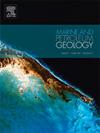Assessment of CO2 storage potential of a saline aquifer in the Gandhar Field, Cambay Basin, India
IF 3.7
2区 地球科学
Q1 GEOSCIENCES, MULTIDISCIPLINARY
引用次数: 0
Abstract
CO2 storage is an important technology for climate change mitigation globally. While broad estimates of the storage potential of India have been reported, pore-space characterization at the reservoir scale is required for site selection. The current research is centered on India's potential pilot CCS project site, the Gandhar Field, located in India's Cambay Basin, with the primary objective of assessing its viability for CO2 storage in a saline aquifer. Our methodology encompasses seismic inversion and in-depth analysis of well-log data to delineate the distribution of porosity within the reservoir, focusing on the GS-7 sand within the Hazad Member of the Ankleshwar Formation. Leveraging probabilistic neural networks, we extrapolate the porosity for the entire reservoir volume. The results reveal that specific areas within the GS-7 sand not only meet but exceed the recommended porosity criteria (>20 %), well surpassing the globally accepted minimum standard (>10 %). We then provide a system to rank different regions in the reservoir with respect to their prospectivity for CO2 storage. Based on these results, we have characterized the GS-7 sand in the Hazad Member as a prospective reservoir zone for CO2 storage.
印度坎贝盆地Gandhar油田含盐含水层二氧化碳储存潜力评估
二氧化碳储存是全球减缓气候变化的一项重要技术。虽然已经报道了对印度储存潜力的广泛估计,但需要在水库规模上进行孔隙空间表征以进行选址。目前的研究集中在印度潜在的试点CCS项目地点,位于印度Cambay盆地的Gandhar油田,其主要目标是评估其在含盐含水层中储存二氧化碳的可行性。我们的方法包括地震反演和对测井数据的深入分析,以描绘储层内的孔隙度分布,重点关注Ankleshwar地层Hazad段的GS-7砂层。利用概率神经网络,我们推断出整个储层体积的孔隙度。结果表明,GS-7砂岩内的特定区域不仅满足而且超过了推荐的孔隙度标准(> 20%),远远超过了全球公认的最低标准(> 10%)。然后,我们提供了一个系统,对水库中不同区域的二氧化碳储存前景进行排名。基于这些结果,我们将Hazad段的GS-7砂层描述为有潜力的CO2储层。
本文章由计算机程序翻译,如有差异,请以英文原文为准。
求助全文
约1分钟内获得全文
求助全文
来源期刊

Marine and Petroleum Geology
地学-地球科学综合
CiteScore
8.80
自引率
14.30%
发文量
475
审稿时长
63 days
期刊介绍:
Marine and Petroleum Geology is the pre-eminent international forum for the exchange of multidisciplinary concepts, interpretations and techniques for all concerned with marine and petroleum geology in industry, government and academia. Rapid bimonthly publication allows early communications of papers or short communications to the geoscience community.
Marine and Petroleum Geology is essential reading for geologists, geophysicists and explorationists in industry, government and academia working in the following areas: marine geology; basin analysis and evaluation; organic geochemistry; reserve/resource estimation; seismic stratigraphy; thermal models of basic evolution; sedimentary geology; continental margins; geophysical interpretation; structural geology/tectonics; formation evaluation techniques; well logging.
 求助内容:
求助内容: 应助结果提醒方式:
应助结果提醒方式:


